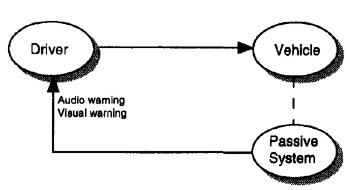Some newer cars have limited passive collision-warning system. For example, Toyota Sienna XLE Limited. It has 8 infrared sensors, 4 are on the bumper at the front and another 4 at the back. Alarm will sound and warn the driver when distance is too close to the car (like this feature). Some others even add back up camera to see what is in the back through a LCD screen on the dashboard.
Passive collision-warning safety systems seek to reduce the risk of a collision by warning the driver of an impending risk so that he or she can take action to avoid the hazard.
There are many systems which provide warnings to the driver. The first warning systems available on production vehicles were typically "parking assist" type systems, which provide an audible tone when parallel parking and approaching a stationary object such as another vehicle or wall. Such systems have also been implemented in school buses, to detect crossing children who may be out of the driver's view. Today there are much more sophisticated systems which use radar and warn occupants of potential impending collisions under normal driving conditions. A passive collision-warning system is shown. As this diagram illustrates, a visual and/or audible warning is signaled to the driver, but there is no active intervention by the system to avoid a collision.
Active safety systems take the collision-avoidance philosophy a stage further by interacting with the powertrain, braking, and even the steering systems. Every manufacturer appears to have a slightly different approach, but the common goal is to sense objects which present a collision risk with the host vehicle, then take preventive measures to avoid an accident. An active collision-avoidance system is shown below. The active system diagram shows that action without the immediate control of the driver is taken in order to avoid a potential collision.
Advanced active collision systems use many clever techniques, over and above object detection, to ensure that a collision-avoidance event is facilitated safely and efficiently. For example, a sensor on the windshield can be used to detect the presence of rain and thus a potentially slippery road surface. In this case, the braking distance would probably be increased, so the hazardous object would have to be detected sooner. Likewise, tire-pressure sensors may be used to report the inflation level of tires, which could also have an effect on stopping distance.
It should be noted that although both the passive (collision-warning) and active (collision-avoidance) systems require object detection, there are differences in how the object detection system is implemented. The object detection performance of a collision-avoidance system must be higher and more robust than object detection for a passive system. It is unacceptable to execute an emergency braking maneuver under false-alarm circumstances. False alarms, while irritating for the driver, are generally considered more acceptable in collision-warning systems. Although the passive systems may allow false alarms more often, a more timely response by the sensor is required, as the reaction time of the driver must be taken into account in the event of an avoidance maneuver.


No comments:
Post a Comment